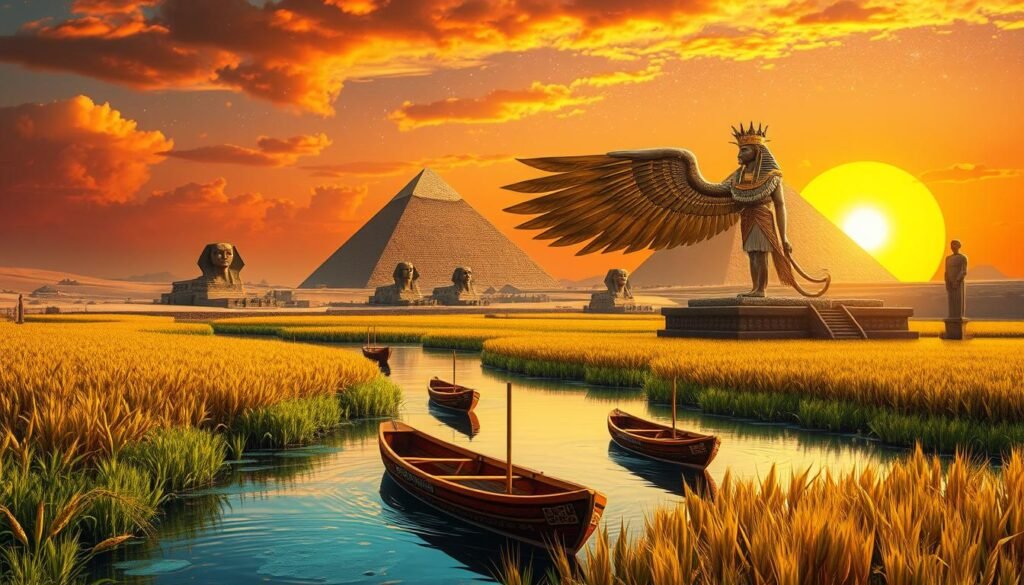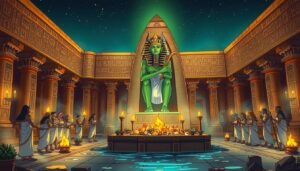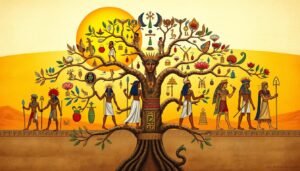In Cairo, the echoes of ancient civilization linger in the air, inviting intrigue and fascination about the beliefs and practices of the people who once inhabited this remarkable land. One of the most captivating aspects of ancient Egyptian culture is their views on the afterlife, a topic that has fascinated historians, archaeologists, and enthusiasts alike for centuries. While many aspects of these beliefs are well documented, misconceptions abound concerning what these ancient people truly thought about death and the hereafter. This leads us to a crucial question: which was not true about Egyptian views of the afterlife? In exploring this question, we delve into the rich tapestry of mythology, spirituality, and ritual that characterized ancient Egyptian beliefs, separating fact from fiction in our quest to understand how they perceived existence beyond the grave.
Key Takeaways
- Explore the common misconceptions surrounding ancient Egyptian beliefs about the afterlife
- Delve into the intricate details of their rituals, mythology, and the journey the soul undertakes to the netherworld
- Separate fact from fiction to gain a deeper understanding of the fascinating customs and beliefs of the ancient Egyptians
- Uncover the true nature of the Egyptian soul concept and the significance of the weighing of the heart ceremony
- Debunk common myths and set the record straight on Egyptian afterlife views
Unveiling the Misconceptions about Egyptian Afterlife Beliefs
The ancient Egyptians’ views on the afterlife are often misunderstood. It’s important to know the truth about their soul concept. This will help us appreciate their beliefs more deeply.
Separating Fact from Fiction
Many think the Egyptian afterlife was simple. But, it was actually complex and rich. Their beliefs included many spiritual elements and rituals that guided the soul to the afterlife.
Exploring the Ancient Egyptian Soul Concept
- The ancient Egyptians believed in the “ka” and “ba,” key parts of the soul.
- The “ka” was the life force or spiritual double. The “ba” was the personality or spirit that went to the afterlife.
- These parts worked together. The “ka” gave sustenance, and the “ba” carried the soul’s consciousness to the next life.
Understanding the Egyptian soul concept helps us see their afterlife beliefs clearly. We learn about the soul’s journey to the next life.
“The Egyptian afterlife was not a simple, one-dimensional existence, but rather a complex and multifaceted belief system that guided the soul’s journey to the next life.”
| Misconception | Reality |
|---|---|
| The Egyptian afterlife was a simplistic, one-dimensional existence. | The Egyptian afterlife beliefs were complex, with a rich tapestry of spiritual components and intricate rituals. |
| The “ka” and “ba” were separate and unrelated concepts. | The “ka” and “ba” were integral parts of the human soul, working in harmony to guide the deceased to the afterlife. |
By clearing up misconceptions, we can better understand the Egyptian afterlife. We see the depth and complexity of their spiritual traditions.
The Intricate Process of Mummification and Burial Rituals
The ancient Egyptians were deeply interested in the afterlife. They practiced egyptian mummification and egyptian burial rituals with great care. These steps were key to helping the deceased reach the afterlife smoothly and keep their soul intact.
The egyptian mummification process was very detailed. It involved removing organs, drying the body, and using resins and oils. This was not just to keep the body intact but also to symbolize the person’s transformation into an immortal being.
The egyptian burial rituals were also very detailed. They included putting the deceased in a sarcophagus, adding personal items, and reciting spells from the egyptian book of the dead. These steps were thought to help the soul overcome the afterlife’s challenges and move on to the next world.
| Mummification Step | Purpose |
|---|---|
| Organ Removal | To preserve the body and prepare it for the afterlife |
| Drying | To remove moisture and prevent decomposition |
| Resin and Oil Application | To protect the body and symbolize the transformation |
The egyptian book of the dead was essential in these rituals. It offered guidance to the deceased as they faced the afterlife’s challenges. This book was believed to help the soul safely reach the next world, where it could be reunited with its body and start a new journey.
Discover The Egyptian Frequency That Transforms You Into A Wealth Magnet—In Just 24 Hours!
The egyptian mummification and egyptian burial rituals were more than just practical steps. They were deeply symbolic, showing the ancient Egyptians’ strong beliefs about the afterlife. These practices still fascinate scholars today, offering insights into ancient Egyptian culture.
The Journey to the Afterlife: The Weighing of the Heart Ceremony
In ancient Egypt, the path to the afterlife was complex. The weighing of the heart ceremony was key. It decided the soul’s fate. This ritual was very important, opening the door to the next life.
Understanding the Symbolism and Significance
The weighing of the heart ceremony was crucial for the journey to the afterlife. The ceremony weighed the deceased’s heart against Ma’at’s feather. Ma’at was the goddess of truth and justice.
If the heart was lighter, it meant the soul was pure. Then, the soul could move on to the afterlife. But, if it was heavier, Ammit, the devouring monster, would eat it. This would mean the soul was lost forever.
- The heart was seen as the center of the soul, containing the individual’s memories, emotions, and moral character.
- The feather of Ma’at represented the divine principle of truth, justice, and cosmic order.
- The balance of the heart against the feather symbolized the deceased’s moral and ethical standing in the afterlife.
This ritual was not just about the soul’s fate. It was also deeply rooted in culture and religion. It showed the importance of living a good life. The outcome of the ceremony would affect one’s eternal existence.
“The weighing of the heart ceremony was a pivotal moment in the ancient Egyptian’s journey to the afterlife, where the deceased’s soul was judged and their fate in the next life was determined.”
which was not true about egyptian views of the afterlife
The ancient Egyptians had a complex belief system about the afterlife. Many myths have stuck around over time. One myth is that they believed in just one afterlife idea. But, their views were actually diverse and changed over time.
It’s not true that Egyptians had one single afterlife idea. Their beliefs changed based on where they lived, their social status, and the time period. While they shared some basic ideas like the soul (ka) and the underworld journey, their views varied a lot.
| Misconception | Reality |
|---|---|
| The Egyptians believed in a single, uniform conception of the afterlife. | The Egyptians’ beliefs about the afterlife were diverse and evolved over time, influenced by regional variations and social status. |
| The afterlife was a fixed, unchanging realm. | The Egyptian conception of the afterlife was dynamic, with different beliefs and practices emerging in different eras and regions. |
| The mummification process was the key to ensuring a successful transition to the afterlife. | While mummification was an important ritual, it was not the sole determinant of one’s fate in the afterlife. Other factors, such as the performance of specific ceremonies and the inclusion of funerary objects, also played a crucial role. |
By understanding the diversity and evolution of Egyptian afterlife beliefs, we can gain a more accurate and nuanced appreciation of this fascinating aspect of their ancient culture.

The Underworld and the Egyptian Mythology of Death
The ancient Egyptians believed in a rich afterlife, deeply rooted in their mythology. This mythology centered on the underworld, called the “Duat.” It was a complex world filled with deities, challenges, and symbols. It gave us a glimpse into their views on death and the afterlife.
Uncovering the Mythological Realms
The Duat, the ancient Egyptian underworld, was a place the deceased had to navigate to reach the afterlife. It was filled with various deities, each playing a role in guiding the dead.
Anubis, the jackal-headed god, was key in mummification and the weighing of the heart. Osiris, the ruler of the underworld, and Ammit, the devourer of souls, were also important.
The deceased faced many challenges in the Duat. These included treacherous paths and fierce guardians. These tests were to see if they were morally and spiritually pure enough for the afterlife.
| Mythological Realm | Significance |
|---|---|
| The Hall of Judgement | The site of the Weighing of the Heart ceremony, where the deceased’s soul was judged based on their moral conduct in life. |
| The Field of Reeds | The idyllic afterlife realm where the worthy souls would reside, enjoying eternal peace and prosperity. |
| The Lake of Fire | The domain of punishment, where the souls of the wicked were believed to be consigned to eternal torment. |
Exploring the ancient Egyptian underworld mythology reveals deep beliefs and symbols. These realms and deities were central to the Egyptian mythology death beliefs.
Discover The Egyptian Frequency That Transforms You Into A Wealth Magnet—In Just 24 Hours!
The Book of the Dead: A Guide to the Netherworld
The ancient Egyptians were deeply interested in the afterlife. The Egyptian Book of the Dead is a key artifact from this time. It was thought to guide the dead through the dangers of the netherworld.
Each Book of the Dead was unique, with spells and prayers for the individual. These texts were written on papyrus scrolls. They were placed in tombs to help the deceased on their journey.
The Book of the Dead covered many topics, like keeping the body and soul safe. Famous spells include “Spell for Preserving the Heart” and “Spell for Uniting the Soul with the Body.” These were crucial for a successful transition to the afterlife.
The Book of the Dead evolved over centuries. As Egyptian beliefs changed, so did the text. But, the Egyptians always aimed to ensure a safe journey for their loved ones.
The Book of the Dead shows the Egyptians’ deep respect for the afterlife. It continues to fascinate people worldwide. It offers a peek into the beliefs of this ancient civilization.
Debunking Common Myths about Egyptian Afterlife Beliefs
Ancient Egyptian beliefs about the afterlife are often misunderstood. By exploring their spiritual traditions, we can see the real beauty of these beliefs.
Setting the Record Straight
Many think the ancient Egyptians believed in a single afterlife. But, this misconception is not true. The Egyptians saw the afterlife as complex, with different realms based on a person’s life and rituals.
Another myth is that Egyptians thought the afterlife was easy to reach. But, the afterlife was seen as a challenging place. The soul had to overcome many obstacles to find peace.
- The ka and ba were key to the Egyptians’ afterlife views, not just life and death.
- Mummification and burial were not just for the body. They helped the soul move to the next stage.
By clearing up these myths, we can appreciate the depth of ancient Egyptian afterlife beliefs. This helps us understand their rich culture and spiritual traditions.
The Influence of Egyptian Afterlife Views on Modern Beliefs
The ancient Egyptians’ views on the afterlife have deeply influenced today’s spiritual and cultural scenes. Even after the Pharaohs fell, the egyptian afterlife beliefs, ancient egyptian underworld, and egyptian mythology death still fascinate us.
The images of mummification and the Egyptian gods have become part of our lives. The idea of an afterlife, where the soul goes on a journey, has touched many beliefs. It has also inspired many artistic works.
The Book of the Dead is a key ancient text for the afterlife. It has influenced modern spiritual and occult practices. Its symbols and myths have been used in today’s spiritual movements, adding mystery and depth to our search for the unknown.
| Ancient Egyptian Afterlife Beliefs | Modern Cultural Influence |
|---|---|
| Mummification and Preservation of the Body | Fascination with Egyptian archaeology and artifacts |
| The Weighing of the Heart Ceremony | Symbolic representations in art, literature, and film |
| The Egyptian Pantheon and Mythology | Inspiration for modern fantasy and science fiction genres |
The impact of Egyptian afterlife beliefs is clear in today’s culture. The ancient egyptian underworld imagery, interest in egyptian mythology death, and exploration of egyptian afterlife beliefs in art and culture show this. This ancient wisdom still captivates and inspires us, reminding us of our eternal quest to grasp life and death’s mysteries.
Discover The Egyptian Frequency That Transforms You Into A Wealth Magnet—In Just 24 Hours!

Conclusion: Preserving the Legacy of Ancient Egyptian Afterlife Traditions
Exploring ancient Egyptian beliefs about the afterlife shows us their lasting impact. These traditions have fascinated scholars and the public for ages. They offer a glimpse into the world of ancient Egypt.
The rituals of mummification and the weighing of the heart ceremony are just a few examples. They show the Egyptians’ deep understanding of death and the afterlife. By studying these traditions, we learn more about history and our own beliefs about life and death.
It’s important to keep the legacy of ancient Egyptian afterlife traditions alive. We can do this through education, research, and cultural exchange. This way, we honor their wisdom and help people appreciate the rich history of human beliefs.
FAQ
What was not true about ancient Egyptian views of the afterlife?
Many think the ancient Egyptians believed the afterlife journey was easy. But, they actually thought it was full of obstacles and trials. The deceased had to face many challenges before reaching their eternal home.
What were the core beliefs of the ancient Egyptians about the afterlife?
The ancient Egyptians had a complex view of the afterlife. They believed the soul, or “ka” and “ba,” would keep going after death. This soul had to journey through the underworld, facing dangers along the way, to reach the afterlife.
What was the role of mummification and burial rituals in the Egyptian afterlife?
Mummification and burial rituals were key to the ancient Egyptians’ afterlife beliefs. They believed mummification kept the body ready for the soul’s return. Burial rituals, including the “Book of the Dead,” helped guide and protect the deceased on their journey.
What was the significance of the “Weighing of the Heart” ceremony in the Egyptian afterlife?
The “Weighing of the Heart” ceremony was crucial in the ancient Egyptians’ afterlife journey. It involved weighing the deceased’s heart against the feather of truth. A pure heart allowed access to the afterlife; an impure heart was devoured by the Devourer.
What were the key components of the ancient Egyptian soul concept?
The ancient Egyptians believed in a complex soul concept. The “ka” was the life force, and the “ba” was the personality and consciousness. These two parts of the soul reunited in the afterlife, allowing the deceased to continue their existence.
What was the role of the “Book of the Dead” in the Egyptian afterlife?
The “Book of the Dead” was a guide for the deceased through the afterlife. It contained spells and instructions to help the soul overcome challenges. Placed in the tomb, it ensured a successful journey to the afterlife.
What were the different realms and deities associated with the ancient Egyptian underworld?
The ancient Egyptian underworld, the “Duat,” was filled with deities and challenges. The deceased met figures like Anubis and Osiris as they navigated the underworld. These encounters were part of their journey to the afterlife.




